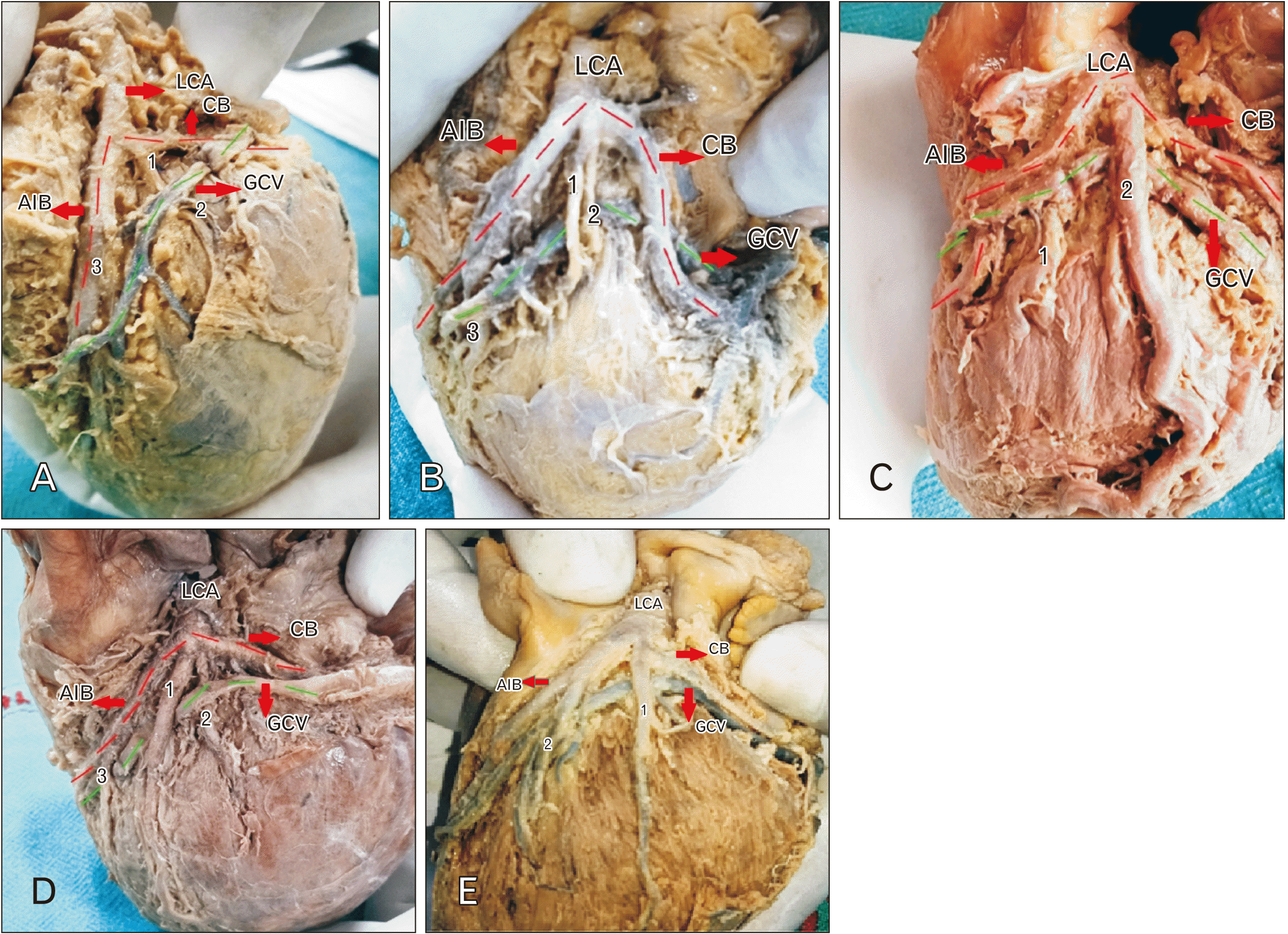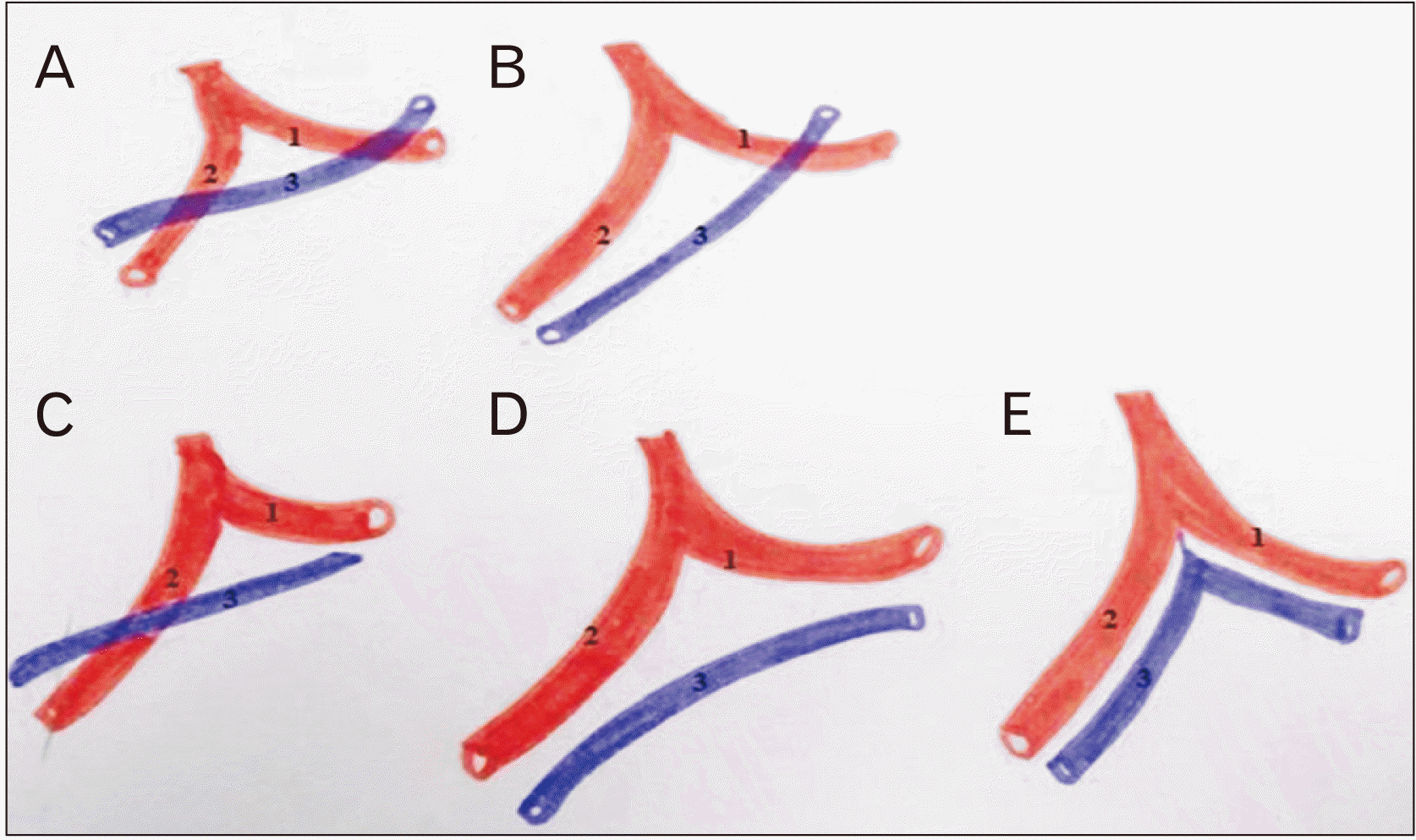The trigone is the site of arteriovenous confluence, formed as GCV ascends and crosses the branches of LCA and forming the triangle of Brocq and Mouchet. The triangle of Brocq and Mouchet was present in 37 (92.5%) hearts and absent in 3 (7.5%) hearts. Above incidence when compared with previous studies which all were cadaveric in nature, it was found to be similar with kulkarni and Ramesh [
5], Kharbuja et al. [
4], Roy and Dubey [
6] with a slight difference with studies done by Sousa-Rodrigues et al. [
1] and Andrade et al. [
7] as shown in
Table 1. The difference in incidence might be due to difference in sample size. Regarding the frequency of type of trigone, pattern found was closed in 19 (51.3%) hearts, followed by inferiorly open in 13 (35.1%), superiorly open in 3 (8.5%) and least was completely open in 2 (5.4%) hearts. Present study was comparable with the studies done by Bharathi and Sathyamurthy [
8] and Roy and Dubey [
6] which also found closed type of triangle in maximum cases followed by inferiorly and superiorly opens and least was completely open. However it got a difference in observation with the studies done by Sousa-Rodrigues et al. [
1] Ortale et al. [
2], Kulkarni and Ramesh [
5], Suma and Shanthini [
9] and Kharbuja et al. [
4] as shown in
Table 2. This might be explained by the fact that sometimes during the removal of epicardial fat and clearing the course of vessels, normal anatomy get disrupted and that results in difference in frequency of each type of triangle. Since the incidence of presence of triangle was 92.5% and frequency of closed type of trigone was most common, it will give an fair idea to the clinician before the procedure on the area whether for implanting bypass grafts, or repairing the left fibrous ring as the shortest distance between coronary venous circle and the left fibrous ring is 5.2 mm at the level of anterolateral commissure of mitral valve. It is the same distance where GCV forms the base of triangle of Brocq and Mouchet. This may be the site of adherence of GCV and myocardium of left ventricular wall. The knowledge of the triangle is essential for coronary sinus cannulation for catheter treatment of arrhythmia and left ventricular pacing as GCV may flex or kink during the procedure [
10]. Regarding the content of trigone, one median artery was found in 15 (40.5%) and two median in 5 (13.5%) hearts. Diagonal artery in the form of median artery was present as the content of the triangle in 39.3% cases reported by Kharbuja et al. [
4], 40% by Kalpana [
11] and 65.3% by Kulkarni and Ramesh [
5]. In present study, in 12 (32.4%) hearts one diagonal arose from AIB and in 4 (10.8%) one diagonal each from AIB and CB and in one (2.7%) heart two diagonals from AIB were seen. Kharbuja et al. [
4] reported diagonal branches from CB were present in eight (28.6%) and diagonal branches from both AIB and CB in eight (28.6%) hearts varying in number from 1 to 2 diagonal branches from each. Relationship of vein with arteries forming the triangle had been studied by various authors. Present study found that GCV to be superficial to both AIB and CB in 37.8% and deep to both in 13.5% in all 51.3% of closed trigone. The pattern observed in superiorly open type of trigone was GCV crossed AIB anteriorly in 8.5% hearts. GCV crossed CB posteriorly in all inferiorly open type of trigone 35.1% as shown in
Table 3. However Kharbuja et al. [
4] found GCV was not crossing any arterial branches in 6.7% (absence of triangle), GCV superficial to both branches in eight (33.3%), GCV deep to both branches in four (16.7%), superficial to one and deep to another in 12 (50.0%), parallel to AIB and crossed CB in four (14.3%), parallel to CB and crossed AIB in one (3.6%). Andrade et al. [
7] found that GCV is parallel to AIB and cross the CB anteriorly in 6 (26.0%) hearts. Sousa-Rodrigues et al. [
1] reported that GCV is parallel to AIB and crossed CB anteriorly in 12 (52.0%) cases, GCV is posterior to AIB and cross CB anteriorly in 5 (22.0%) cases and no heart was found where GCV crossed both the branches. Nevertheless on comparison relationship differs between the studies that indicate further studies to be conducted to know the relationship between GCV and both arterial branches. If the position of GCV lies deep to either of rigid wall of AIB or CB, it may cause compression of the vein resulting in altered venous return. Gerber et al. [
12] suggested that percutaneous coronary artery bypass grafting is not suitable in individuals with crossing of AIB and GCV since the site of overlap can mask the calcification of artery. After observing the different pattern of relationship of GCV with AIB and CB in a trigone, authors formed following classification and a schematic is drawn in
Fig. 3.
 | Fig. 3A schematic diagram showing various possibilities of relationship between great cardiac vein with anterior interventricular branch and circumflex branch. 
|
Table 1
Comparing the incidence of triangle of Brocq and Mouchet from previous studies
|
Authors |
Sample size |
Presence of triangle (%) |
Absence of triangle (%) |
|
Kharbuja et al. [4] |
30 |
93.3 |
6.7 |
|
Kulkarni and Ramesh [5] |
52 |
93.3 |
3.0 |
|
Andrade et al. [7] |
23 |
86.9 |
11.1 |
|
Sousa-Rodrigues et al. [1] |
26 |
88.0 |
12 |
|
Roy and Dubey [6] |
30 |
93.3 |
6.7 |
|
Present study |
40 |
92.5 |
7.5 |

Table 2
Comparing the frequency of type of triangle of Brocq and Mouchet from different studies
|
Classification of the triangle |
Sample size |
Population |
Closed (%) |
Superiorly open (%) |
Inferiorly open (%) |
Complelety open (%) |
Absent |
|
Sousa-Rodrigues et al. [1] |
26 |
Brazil |
35 |
4 |
52 |
9 |
12 |
|
Ortale et al. [2] |
37 |
Brazil |
18 |
3 |
64 |
15 |
|
|
Bharathi et al. [8] |
30 |
South India |
50 |
10 |
20 |
6.7 |
13.3 |
|
Roy and Dubey [6] |
30 |
North India |
46.4 |
14.3 |
28.6 |
10.7 |
6.7 |
|
Kulkarni and Ramesh [5] |
52 |
South India |
38 |
10 |
37 |
12 |
3 |
|
Suma and Shanthini [9] |
104 |
South India |
6.7 |
0.9 |
87.5 |
1.9 |
2 |
|
Kharbuja et al. [4] |
30 |
Nepal |
24 |
1 |
3 |
0 |
6.7 |
|
Present study |
40 |
North India |
51.3 |
8.5 |
35.1 |
5.4 |
7.5 |

Table 3
Relationship of GCV with AIB and CB
|
Variable pattern of GCV with AIB and CB |
Value (n=37) |
|
GCV anterior to AIB and CB |
14 (37.8) |
|
GCV posterior to AIB and CB |
5 (13.5) |
|
GCV anterior to AIB (not crossing CB) |
3 (8.1) |
|
GCV posterior to CB (not crossing AIB) |
13 (35.1) |
|
GCV not crossing AIB or CB (completely open triangle) |
2 (5.4) |

Type IIA: Anteriorly crossing one of branch either AIA and CA and parallel to another
Type IIB: Posteriorly crossing one of branch either AIA and CA and parallel to another
According to above classification maximum pattern observed in present study was type IA followed by type II A and type II B and least was type III. After comparing the relationship of GCV with both arterial branches, present study studied the relationship between GCV and content of trigone
i.e. diagonal branches. Authors found three type of arrangement 1) GCV is anterior to median artery 2) GCV is posterior to median artery 3) GCV is anterior to some and posterior to other diagonal branches. In majority of cases in present study GCV is deep to median artery and the median artery was too of big lumen and it other cases where there were small diagonal branches, then mostly GCV is anterior to contents. When comparing with previous studies von Lüdinghausen [
13] indicated that in 70% of the cases the GCV passes anterior to the diagonal artery and that in 29% it does so posteriorly. Sousa-Rodrigues et al. [
1] reported that MCV crossed anteriorly and posteriorly to the diagonal artery in 57% and 43%, respectively. James [
14] reported that when minor ventricular branches were present inside the trigone, they were crossed anteriorly by the GCV in a greater percentage (52%) than posteriorly (26%) means anterior crossing is frequent. The content of triangle was median artery in all the hearts. The specialty of median artery is that it does not run in any cardiac groove and has unusual course in human beings. The median artery is source of anterior septal branches and to anterior papillary muscle of left ventricle. Its presence reduces risk of atherosclerosis of left anterior interventricular artery and circumflex coronary artery. Median artery is a constant feature of rabbit, monkey, squirrel monkey and pig hearts [
15]. In conclusion the incidence of closed type of trigone with median artery as a predominant content is found in maximum hearts. The mean area of the triangle was 246.3 mm
2. The results of this research will complement the anatomical knowledge of the vascular trigone in question and therefore will be a contribution to the surgical anatomy of this important organ. Thus detailed anatomical knowledge of the triangle will help cardiologist to achieve results with least complications.






 PDF
PDF Citation
Citation Print
Print




 XML Download
XML Download